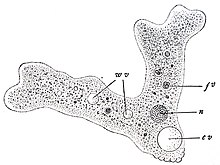Endoplasm
The endoplasm , also entoplasm or entosark, is the central, inner, part of the cytoplasm of many unicellular organisms. The outer part of the cytoplasm is called the ectoplasm , and both differ in their consistency. Both types of plasma are not fundamentally different, but only differ in the different distribution of intraplasmic organelles.
Layout and function
The endoplasm contains all central organelles such as the cell nucleus , mitochondria , endoplasmic reticulum as well as food vacuoles and other components of the cell.
In contrast to the viscous ectoplasm (plasma gel), the endoplasm has a liquid consistency and is therefore known as plasma sol. Especially when pseudopodia are formed , the two components mix (gel-sol transitions); the ectoplasm liquefies and flows towards the pseudopodium while the endoplasm flows into the pseudopodium and becomes more viscous at the edge. When uncoated amoebas move , there is a contraction in the ectoplasm mediated by actin , causing the liquid endoplasm to develop a current and flow into the pseudopodium.
supporting documents
- ↑ a b c Keyword "Endoplasma" in: Herder-Lexikon der Biologie. Spectrum Akademischer Verlag GmbH, Heidelberg 2003. ISBN 3-8274-0354-5 .
- ↑ Keyword “Ectoplasm” in: Herder-Lexikon der Biologie. Spectrum Akademischer Verlag GmbH, Heidelberg 2003. ISBN 3-8274-0354-5 .
